Dell Inspiron Mini 9 Reviewed: Refining the Netbook Market
by Anand Lal Shimpi on September 4, 2008 12:00 AM EST- Posted in
- Laptops
Build Quality, Oh Sweet Build Quality
Here’s where ASUS falls short and Dell succeeds: the Inspiron Mini 9 feels like it’s worth much more than you’re paying for. The Eee PC, especially the 901 is actually not all that low-cost, and while build quality has improved it's still not perfect. The problem for ASUS is that the Inspiron Mini 9, at $349, feels like a more expensive product. Consider the bar raised.
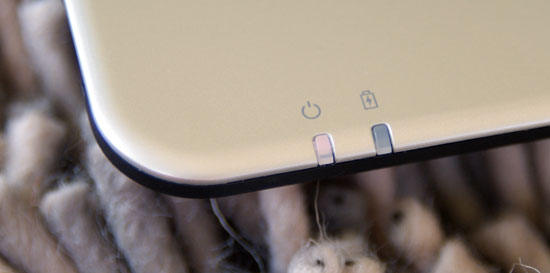
That's right, white LEDs
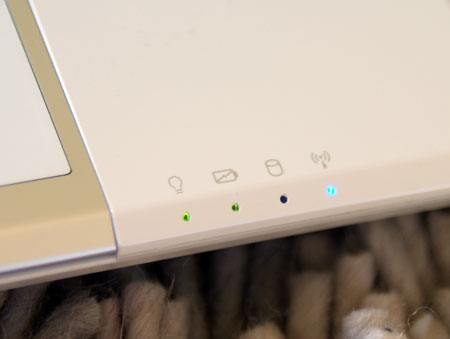
The equivalent on the Eee PC. The Dell looks more...Apple-like
This thing feels amazing, it’s the MacBook Air meets the Eee PC. There are $1500 notebooks that don’t feel this put together. Dell has been promising me that over the next 12 - 18 months that their products are going to get significantly better in terms of functionality, build quality and design - the Mini is the first example of just that. That's not to say that the Eee PC was bad, far from it, it's just that the Mini is better.
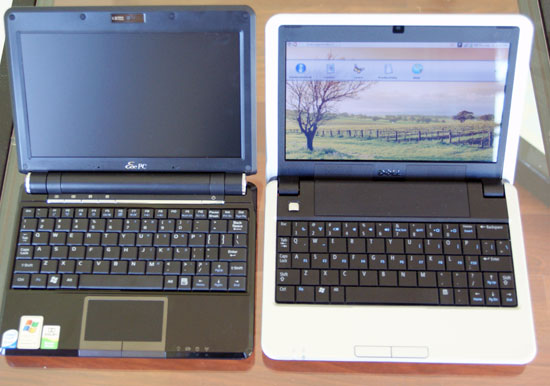
Eee PC (left) vs. Inspiron Mini 9 (right)
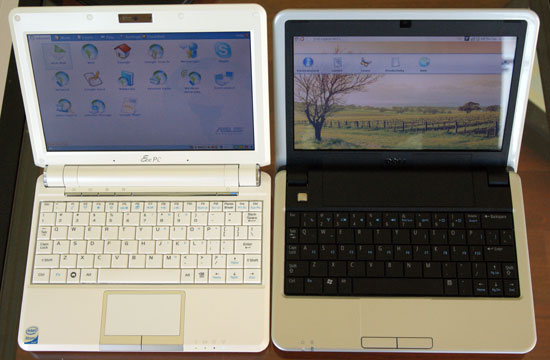
Eee PC (left) vs. Inspiron Mini 9 (right)
Stylistically the Inspiron Mini 9 borrows a lot from the Eee PC. The beveled edge on the top cover is nearly identical to that on the Eee PC 901. Even the back of the screen is nearly identical, but Dell improved upon ASUS’ design by softening one of the harder angles on the Eee PC.
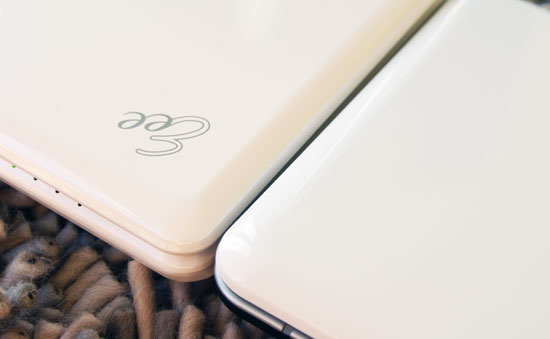
Eee PC (left) vs. Inspiron Mini 9 (right)
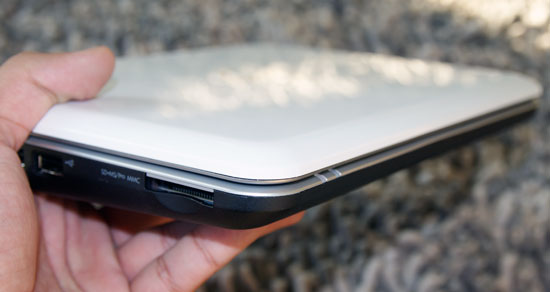
Part of Dell’s trick to making the Inspiron Mini feel more expensive than it is has to do with materials choices on the inside. The frame around the screen and keyboard are made of the same material, and it hides fingerprints. The Eee PC on the other hand mixes two different types of coating and the area around the keyboard happens to show fingerprints/grease a little too well, regardless of whether you got the white or black version.
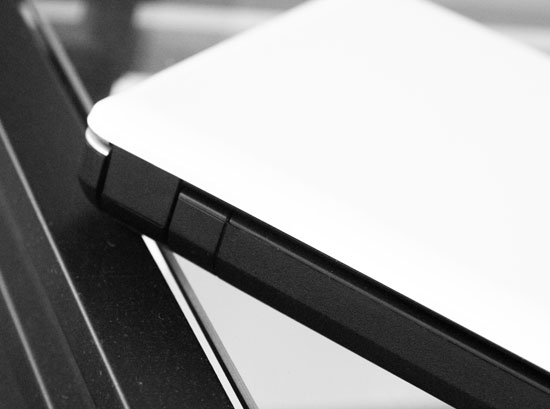
The Mini's hidden hinges

Dell also hid its hinges as best as it could with the Mini, while ASUS displayed them prominently on the Eee PC. Stylistically, the Inspiron Mini looks more modern, while the Eee PC is more reminiscent of the notebooks of yesteryear. Given the low price point of these devices, you expect slightly older styling, but again - Dell raised the bar with the Inspiron Mini.
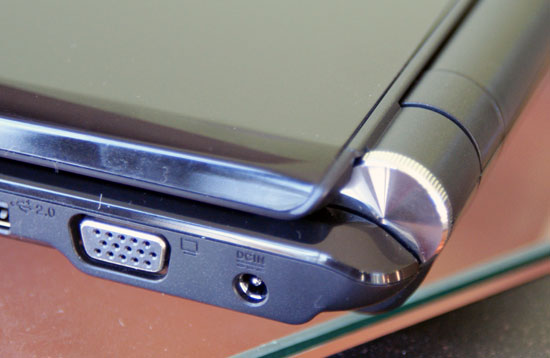
ASUS' exposed hinges










55 Comments
View All Comments
rowcroft - Thursday, September 4, 2008 - link
I have an Acer Aspire 1 - $349 for the 120GB HDD, XP (need it for WWAN card), 1GB RAM, but no bluetooth.Still, I think it's a much more compelling offer than either this or the Asus and suggest you get one to evaluate.
strikeback03 - Thursday, September 4, 2008 - link
I think that picture at the bottom of the first page shows why I hate glossy screens.What I am waiting for is someone to come out with a device that falls somewhere between an Epson P5000 and an Archos 5" internet tablet. Run a real OS, have a decent sized hard drive for music and photo downloads, multiple card readers, touchscreen, and the ability to go on the internet occasionally if it is around. Closest netbook is the Wind or possibly the Lenovo it would seem, but I wouldn't plan on typing enough to need a real keyboard.
prophet001 - Thursday, September 4, 2008 - link
seriously, 118 wpm? how in the world did you get that fast? i've been typing everyday for 6 years and I can't type that fast. Any tips?preslove - Thursday, September 4, 2008 - link
I'm torn now between betting the Dell Mini 9 or the EEE pc 1000H. There really isn't any reason to buy EEE 901, since it is more expensive than the 1000H, which is $549.99, and is only .8 pounds lighter. The 1000H has a much roomier keyboard that is supposedly closer to a "real" notebook's keyboard than a netbook.Two major advantages of the 1000H over the Dell, though, are that it comes with an 80 gig hd and a 6 cell battery. Also it comes with 1 gig of Ram standard.
Adding all the options to the Dell, Win XP, ram upgrade, camera upgrade, and bluetooh and it adds up to $494. That's $65 less than the 1000H, which has a better keyboard and a good sized hard drive, but is about a pound heavier.
I wish these two were in stores so I could compare the weight and keyboards, as that would probably help be choose.
One question: Can the Mini accept a 2 gig stick of Ram?
tayhimself - Thursday, September 4, 2008 - link
Yes 2 GB RAM interest here too. The Acer Aspire looks good to me as well.JarredWalton - Thursday, September 4, 2008 - link
10" netbooks actually start to become viable as a full-time laptop... almost. I'm not Ben, but I'm right with him in terms of typing on these things. I draw the line of comfort at 13.3" notebooks. Predictive typing would help some, but with the width of my shoulders I still end up feeling cramped on anything smaller. (Why can't I get a natural keyboard on a laptop? LOL)However, the above said, 10" is still small and I think too many people are looking at these as a full notebook/desktop replacement rather than a mobile device that supplements regular computer use. 2GB RAM and 80GB HDDs... and then next we'll need faster CPUs and discrete GPUs, and an optical drive, and.... It's a slippery slope, and I think you should either get a real notebook (13.3" or larger - or 12.1" if you don't mind the smaller keyboards) or understand that the netbook is not supposed to be a full notebook and use it as intended. For $350, the Dell Mini looks extremely promising.
n0nsense - Thursday, September 4, 2008 - link
I think the perfect one should be:1. Little bit more powerful processor (Atom dual core or AMD X2)
2. More advanced chipset (less heat more graphics performance and output options) which will allow playback of 1080p on TV.
3. Normal 2.5" HDD/SDD options for upgrade.
4. I would like touchscreen (multi touch is even better)
The rest i think is very close to be perfect.
The reason is for all this more performance is:
Try to listen to some last.fm radio on the web + some fullscreen flash web page or game.
And yes, i know, all this "more" will kill more expensive notebooks.
psychobriggsy - Friday, September 5, 2008 - link
1) Yes, a dual-core Atom would be nice, but it is already multi-threaded (whoa, what's up with this text box, it's gone all funky!)1b) AMD (soon will) have a 22W 1.5GHz X2. I don't know how much power it uses when PowerNow! is enabled, but AMD need to get a standard Athlon 64 out first that has PowerNow! ranges starting from 400MHz at very low voltage first. They do have a 15W Athlon 64 coming out soon as well.
2) This is the most important aspect, and where all the Atom netbooks are failing right now. It's almost criminal.
3) Really unimportant, these are mobile companions. Bet Palm feels stupid in cancelling the Foleo, when it turns out that form factor is what people want.
4) That Dell Linux interface would be perfect for touchscreen.
JarredWalton - Friday, September 5, 2008 - link
You do know that Atom N270 is like 1.5W TDP, right? http://download.intel.com/design/processor/datasht...">Reference A 22W 1.5GHz X2 would use over 10X as much power as the N270. The problem right now is the chipset; we need Poulsbo.psychobriggsy - Friday, September 5, 2008 - link
And the multi-threaded Atom is 2.5W, and the 64-bit Atom is 4W, and the dual-core Atom will be 8W.Also Paulsbo will suck, it's designed for MIDs, maybe the netbooks will be okay with it, but barely. It's a 130nm chip so however cool running the process they are using, it's limiting the clock speed of the GPU, and the number of features it can have.
AMD have an 8W Athlon 64 already, and in reviews the platform consumes less power and outperforms Atom - in a desktop scenario.